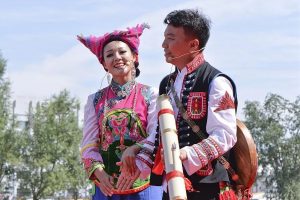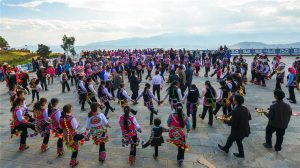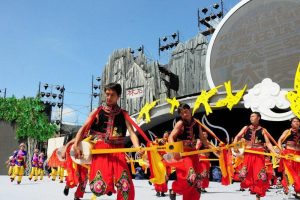 alt="Market Days in Menglian and Townships, Puer"
/>
alt="Market Days in Menglian and Townships, Puer"
/>
New Life of Yi Ethnic Minority
The founding of the People’s Republic of China in 1949 ended the bitter history of enslavement and oppression of the Yis and people of other nationalities in China. From 1952 to 1980, the Liangshan Yi Autonomous Prefecture of Sichuan, the Chuxiong Yi Autonomous Prefecture and the Honghe Hani and Yi Autonomous Prefecture of Yunnan were established one after another. Autonomous counties for the Yi or for several minority groups including Yi were founded in Eshan, Lunan, Ninglang, Weishan, Jiangcheng, Nanjian, Xundian, Xinping and Yuanjiang of Yunnan, Weining of Guizhou and Longlin of Guangxi.

Transformation of the only existing slave society in the contemporary world over the past 30 years or more has been a matter of profound significance in the Yi people’s history. In response to the aspirations of the Yi slaves and other poor people, the people’s government, after consulting with Yis from the upper stratum who had close relations with the common people, decided to carry out democratic reforms in the Yi areas of Sichuan and in the Ninglang Autonomous County of Yunnan in 1956. The basic objective of the democratic reforms was to abolish slavery and let the laboring people enjoy personal freedom and political equality; to abrogate the land ownership of the slave owning class and introduce the land ownership of the laboring people to release the rural productive force and promote agricultural production so as to create conditions for the socialist transformation of agriculture and the movement of co-operation.
In accordance with the principle of peaceful consultation, the people’s government granted an appropriate political status and commensurate material benefits to those upper stratum people who actively assisted with democratic reforms. In this way, many slave owners were won over, while the few unlawful and intransigent slave owners were isolated. Thus, democratic reforms went on smoothly.

In the spring of 1958, democratic reforms concluded in the Yi areas in the Greater and Lesser Liangshan Mountains in Sichuan and Yunnan. The reforms destroyed slavery, abolished all privileges of the slave owners, confiscated or requisitioned land, cattle, farm tools, houses and grain from the slave owners, and distributed them among the slaves and other poor people. In the Liangshan Yi Autonomous Prefecture and the Xichang Yi areas, 120,000 hectares of land were confiscated, and 280,00 head of cattle, 34,000 farm tools, houses composed of 880,000 rooms and 8,000 tons of grain were either requisitioned or purchased and given to the poor and needy along with 4,700,000 yuan paid as damages by unlawful slave owners. The reforms emancipated 690,000 slaves and other poor people, making them masters of the new society.
The people’s government also built houses and provided farm tools, grain, clothes, furniture and money for the slaves and other poor people and helped them build their own homes. In the Liangshan Mountains, the government set up homes for 1,400 old and feeble slaves who had lost the ability to work under slavery. Many former slaves got married and started their own families, and many families were reunited.
The emancipated slaves took the socialist road most firmly and shortly after the democratic reforms formed advanced cooperatives in agricultural production.
The democratic reforms inspired the emancipated slaves and poor peasants to reshape their land and expand agricultural production steadily. The Chuxiong Yi Autonomous Prefecture of Yunnan achieved a great success in increasing output of hemp, tobacco, cotton, peanut and other cash crops. The autonomous counties of Ninglang, Weishan and Eshan in the Honghe Yi Autonomous Prefecture built water conservancy projects, which have played a big role in farming.
There was no industry at all in the Yi areas in the pre-liberation days except for the Gejiu Tin Mine in Yunnan and a few blacksmiths, masons and carpenters taken from the Han areas to the Liangshan Mountains. Now people in the Liangshan, Chuxiong and Honghe autonomous prefectures have built farm machinery, fertilizer and cement factories, small hydroelectric stations and copper, iron and coal mines.

Lack of transportation facilities was one of the factors contributing to the seclusion of the Liangshan Mountains. Construction of roads started right after liberation. In 1952, the highway connecting Sichuan and western Yunnan was reconstructed and opened to traffic. At the same time, trunk highways linking the Liangshan Autonomous Prefecture with other parts of the country were constructed. The Yixi Highway was opened to traffic in 1957, linking up the Greater and Lesser Liangshan Mountains for the first time in history. A highway network extending in all directions within the prefecture had been formed by 1961. By the end of 1981, the total length of highways in the prefecture had increased from seven km. before 1949 to 7,368 km. While there were only 18 push carts in the whole area before 1949, the number of vehicles in 1981 reached 11,000, of which 5,000 were motor vehicles.
The local transportation department employed a total of 10,000 people. The Chengdu-Kunming Railway crosses six counties in the Liangshan Yi Autonomous Prefecture over a distance of 337 km., with 45 stations on the line.
With the development of the local economy, people in the prefecture had built 1,480 hydroelectric stations with a total generating capacity of 97,000 kw. By 1981, providing electric power and lighting for 80 per cent of the area.

Being extremely backward in education in the old days, the Yi people now have primary schools in all villages. The autonomous prefecture began setting up middle schools, secondary technical schools and schools for training ethnic teachers in the late 1950s. In 1981, there were 180 middle schools with 220 minority teachers and 12,000 students, 3,780 elementary schools with 3,700 minority teachers and 66,900 pupils. Children of emancipated slaves and poor peasants now have access to education. A new generation of Yi intellectuals with socialist consciousness is coming to the fore, and many Yi cadres hold leading positions at all levels of government in the prefecture.
In the past, there were no professional doctors, and the only way to avert and cure diseases was to pray. Now there are hospitals and clinics in all counties. Serious epidemic diseases such as smallpox, typhoid, leprosy, malaria, cholera have either been brought under control or wiped out by and large. A lot of traditional medical experience of the Yis has been collected, summed up and improved. The world famous Yunnan baiyao (a white medicinal powder with special efficacy for treating haemorrhage, wounds, bruises, etc.) is said to have been prepared according to a folk prescription handed down for generations by Yi people in Yunnan.
The colorful literature and art of the Yis are flourishing. The Yi people have created a great deal of historical and literary works written in the old Yi language and folk literary works handed down orally. The oral folk literary works, numerous and in a great variety, include poems, tales, fables, proverbs, riddles, etc. History of the Yis in the Southwest and Lebuteyi, two encyclopedic works written in the old Yi language and involving philosophy, history and religion have been translated into the Han (main Chinese) language. The epics Ashima, The Song of the Axi People and Meige are popular throughout Yunnan.
Since liberation, many Yi folk tales, epics and songs have been published after being collected and collated. Also published are some new works reflecting the present life of the Yi people, such as The Merry Jinsha River and Daji and His Father. Yi songs and dances are rich in ethnic color. The new folk song The Stars and the Moon Are Together expresses through beautiful melodies the happiness and warmth felt by the Yis in the great family of nationalities in China. The Happy Nuosu, another new song with cheerful and lively melodies, reflects the joyous and energetic life of the Yi people.

 7 Days GolfingTour
7 Days GolfingTour
 8 Days Group Tour
8 Days Group Tour
 8 Days Yunnan Tour
8 Days Yunnan Tour
 7 Days Shangri La Hiking
7 Days Shangri La Hiking
 11 Days Yunnan Tour
11 Days Yunnan Tour
 6 Days Yuanyang Terraces
6 Days Yuanyang Terraces
 11 Days Yunnan Tour
11 Days Yunnan Tour
 8 Days South Yunnan
8 Days South Yunnan
 7 Days Tea Tour
7 Days Tea Tour
 8 Days Muslim Tour
8 Days Muslim Tour
 12 Days Self-Driving
12 Days Self-Driving
 4 Days Haba Climbing
4 Days Haba Climbing
 Tiger Leaping Gorge
Tiger Leaping Gorge
 Stone Forest
Stone Forest
 Yunnan-Tibet
Yunnan-Tibet
 Hani Rice Terraces
Hani Rice Terraces
 Kunming
Kunming
 Lijiang
Lijiang
 Shangri-la
Shangri-la
 Dali
Dali
 XishuangBanna
XishuangBanna
 Honghe
Honghe
 Kunming
Kunming
 Lijiang
Lijiang
 Shangri-la
Shangri-la
 Yuanyang Rice Terraces
Yuanyang Rice Terraces
 Nujiang
Nujiang
 XishuangBanna
XishuangBanna
 Spring City Golf
Spring City Golf
 Snow Mountain Golf
Snow Mountain Golf
 Stone Mountain Golf
Stone Mountain Golf













 What Our Customers Say?
What Our Customers Say?
